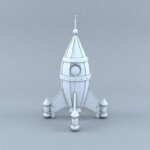Silent productivity killer: Troubleshooting peak performance by mastering boring CNC tools
In CNC machining, few things can be as frustrating as the subtle and devastating effects of dealing with dull tools. Continuous decline in surface quality, sudden rise in cutting forces or unexpected chats spread into your workpiece – all pointing to a common culprit: losing the edge of the tool that bites. Dull tools not only cause you inconvenience. They are the main loss of productivity, resulting in parts abandonment, machine damage and expensive downtime. Understanding how to discover, troubleshooting and prevent sluggishness is essential to maximize efficiency and maintain high accuracy required by project requirements. At Greatlight, we specialize in complex five-axis CNC machining that requires metal parts, and we have witnessed first-hand how mastering tool management separates good stores from big stores.
Why do CNC tools lose their advantages? The culprit explained
Tool blunt is an inevitable result of friction and high pressure contact with difficult workpiece materials, but several factors accelerate IT:
- Material characteristics: Hard materials (such as titanium alloys, hardened steel or inconel) can produce severe heat and wear, quickly wearing the cutting edges. Soft, fondant materials (such as aluminum, some plastics) may cause adhesion or internal edges (BUE) where the workpiece material welds itself to the edge of the tool, effectively passivating it.
- Overcut parameters: Working to push the tool with excessive attack speed (SFM) or feed (IPR/IPM) can generate excessive heat and impact loads. Instead, run Too slow May cause friction rather than shearing, speeding up the abrasive.
- Inadequate cooling/lubrication (coolant/MQL): The coolant flow rate is insufficient, and the coolant concentration or improper spray pattern cannot effectively remove heat and chips. This causes thermal softening of the tool, accelerated diffusion wear and increased adhesion. At Greatlight, we have carefully optimized coolant delivery on advanced five-axis machines for each project.
- Incorrect toolpath policy: Unnecessarily long-term participation time, drastic direction changes, excessive steps or drops can concentrate heat and wear on specific parts of the tool.
- Tool selection difference: The use of tool substrates (HSS, K, M, M, P), coatings (Tialn, AlcRN, TICN) or geometry is not suitable for specific materials and operations greatly reduces tool life.
- Tool holder and machine stiffness: Vibration and tremor are often caused by insufficient machine stiffness, tool clamping (hopping), or worn spindle bearings, which can lead to micro-cutting and rapid edge degradation.
- CHIP evacuation issues: The recovery chip (especially in deep cavity/pocket) wears the edges of the tool considerably.
Identify signs of boring tools
Catching the sluggishness as soon as possible is the key. Note these symptoms:
- Deterioration of surface effect: The most obvious sign. Look for increased roughness, visible feed marks, stripes, tears (with aluminum) or polished surfaces.
- Burning mark: Discoloration on the workpiece or chip (blue, brown, dark gray) indicates excessive heat, usually due to dull edges.
- Increase cutting force: Listen to the change – a loud scream, scream or groaning sound. Monitoring machine load gauge (spindle load, shaft servo load); gradual increase is an obvious indicator. The machine may even accidentally stall.
- Unusual chip formation: Produce too long debris (rather than forming good curls or breaks) or very short, discolored/dark blue/debris. The volume may increase too much.
- Increase vibration and chat: Loud, resonant vibrations can damage parts and machine structure.
- Dimension inaccurate and taper: Boring tools can deflect more, resulting in intolerance, especially in deep cuts or tight tolerances. You may see unexpected taper in holes or walls.
- Edge check (physical check): Visually, a sharp tip should have a unique, sharp line with magnification. The blunt edges appear round, broken, peeled or worn on the sides. The large amount of rake surfaces near the edges are also wear indicators.
Troubleshooting and recovery: Back on track
After doubting bluntness, please take a systematic approach:
- Confirm the symptoms: Don’t assume. Suspend work. Visually inspect the surface finish of the workpiece. Listen to the machine during a mild pass. Check the machine load indicator. Verify the size for CAD.
- Check for suspicious tools: Remove the tool carefully. Clean thoroughly. Check the cutting edges with strong light and magnification (shop microscope or glasses) for rounding, debris, side wear land (VB), mountain pass or bue. Compared to known sharp tools.
- Replace or repair tools: If wear is very large (e.g. VB> 0.010" For rough, > 0.003" To complete), replace it immediately or send it for expert re-enrollment. Crucial: Ensure that new tools are precisely the correct type, geometry and paint for your specific materials and operations. Don’t assume "Same size" method "Same tool."
- Research the root cause: This is crucial to prevent recurrence.
- Check out your CAM program: Is the speed/feed appropriate? Is the tool path optimal (reduces corner engagement and minimizes fast exit/re-entry)? Consult the tool manufacturer data sheet.
- Check coolant: Is the flow rate of the cutting area (visible spray) sufficient? Is the concentration correct (using a refractometer)? Is the nozzle exactly aimed at? If applicable, consider switching coolant type or using MQL (minimum quantity lubrication).
- Check Tool Fixed: Use the dial indicator at the tip position to check for excessive tool jumps. Make sure the chuck/nut/holder is clean and not damaged.
- Assessing machine condition: Check for excessive spindle vibration, strong rebound on the shaft or other mechanical problems. Tool-like machines require maintenance.
- Comment Material: Have the inventory material batch changed? If possible, verify its exact specifications and hardness.
- Adjust parameters (if required): If the root cause points to the parameter (speed/feed/doc), make the calculated adjustments based on tool data or manufacturer’s recommendations. Don’t make huge changes without reason.
- Implement Tool Life Management (TLM): Use the computer’s TLM function to automatically track the runtime of each tool and trigger an alarm before the tool becomes very dull. This is especially important for large batches or long-term running.
Active prevention: Strategies to maximize tool life
One ounce of prevention is the value of troubleshooting:
- From the beginning: Use tool manufacturer’s expert data and software to select the best tool substrates, paints and geometry for your specific job. This is not a guessing game. Greatlight uses deep materials science knowledge to select our complex five-axis work tools.
- Religious optimization cutting parameters: Basic speed and feed Verified Recommended and calculated chip load. If possible, use simulation software. err is slightly conservative to achieve critical finishes.
- Optimization of the main tool path: High efficiency strategies such as Trochoidal milling, peeling or insert milling are adopted to evenly distribute wear and reduce heat buildup. Minimize unnecessary air cutting.
- Ensure impeccable cooling/lubrication: Strictly maintain the coolant concentration. Make sure the nozzle is properly positioned and not blocked. Consider using tools with higher pressures to require deep holes or high temperature applications. Use chip circuit breakers efficiently.
- Prioritize rigidity: Insert with the shortest tool. Invest in high-quality low-running tool holders (hydraulic, suitable for contraction). Make sure your CNC machine spindle is properly maintained.
- Embrace Tool Life Management: Regularly record runtime and inspection tools. Actively set conservative runtime restrictions.
- Regular inspection plan: Don’t wait for failure. Schedule regular visual and audible checks during operation and perform more detailed amplification checks after critical time intervals.
Conclusion: Work accurately to eliminate downtime
Tools that deal with boring are essential to running profitable and effective CNC operations. Recognizing early signs, methodical solution to root causes, and implementing strong preventive measures are not optional skills; they are critical to achieving the high precision, surface quality and efficiency required for modern manufacturing, especially in complex five-axis work.
At Greatlight, our mastery of advanced five-axis CNC machining is not just a machine, but a deep understanding of how to ensure that every tool on the spindle performs at the best performance. Our expertise in material behavior, cut-off dynamics and process optimization allows us to always prevent premature tool wear and provide complete metal parts as well as a comprehensive after-processing service. Don’t let dull tools derail your next precision project.
Confidently customize precision parts. Experience Greatlight Differences – Advanced technology pairs with expert execution. Get your quote at the best price today!
FAQ: Troubleshooting CNC Tools
Q1: How often should I change the CNC tool? Is there standard time?
A1: No universal timer! Tool life is acutely dependent on the material processed, the specific tool type/coating, selected speed/feed, coolant efficiency and type of operation (rough vs. finish). The most reliable methods are: 1) implement tool life management (TLM) in a CNC controller, 2) check the tools regularly during production runs, and 3) 3) follow well-documented tool life data from tool vendors adjusted to your specific conditions. Tools based on measurement wear or degradation output, not just a few hours.
Q2: Actually, coolant can be reason Tool blunt?
A2: Yes, improper use of coolant will make contributions. If the coolant does not reach the exact cutting interface (blocking nozzles, misalignment, low flow), the tool overheated and wears soared. use Wrong The type of coolant of the material (e.g., some coolants promote bue in aluminum) or incorrect concentrations (too weak = no cooling/lubricating, too strong = can cause chemical reactions or viscous residues) can be harmful. Optimizing coolant delivery and chemistry and cutting parameters is essential in itself.
Question 3: Are high-priced coating tools worth preventing passivation?
A3: Absolutely, especially for titanium, steel with content or hardened or challenging materials with high productivity/high temperature conditions. Modern coatings such as Altin, ALCRN or nanocomposites greatly reduce friction and heat loads, thus preventing wall gaps and diffusion wear. This translates into significantly longer tool life, better finishes, and often even higher viable cutting speeds, which, despite the higher initial tool costs, will ultimately reduce costs. In the long run, investing in the right coating tool is often cheaper than constantly replacing cheap, uncoated jobs.
Q4: What is the difference between abrasive wear and build edges (bue)? How can I fix them?
A4: Abrasive wear It is the gradual erosion of the tool edge due to the recovery of hard particles in the workpiece material or the solidified chip. It can cause side wear and rounding. Prevention: Harder tool substrates (e.g., particulate carbides), harder coatings, optimized feeds (not too slow), good chip evacuation.
bow This occurs when the workpiece material is welded (adhesive) to the tool tip. This is established "piece" Like a blunt cutting surface, it leads to tears and poor results. It plagues soft fudge material and low speed. Prevention: Clearer tool geometry, higher speeds, optimized coatings (lubricating grade), dry cutting or MQL strategy (specially designed for aluminum).
Fixing either requires replacement/reloading of the tool and then adjusting the processing parameters or paint to solve the root cause.
Q5: My tools will become dull soon. What should I check first?
A5: Start with fundamentals: 1) Speed and Summary: Recalculation based on tool manufacturer data Your exact material; Make sure the SFM and chip are correct. 2) Coolant: Verify sufficient flow at the cut and correct concentrations. 3) Tool selection: Carefully check the tool material/substrate and coating to fit the material. 4) Jump: Measuring tools jump; excessive jumping ruins fast edges. 5) Tool path: Analyze whether excessive participation or friction occurs. These are the most common culprits behind unexpected quick tool failures.

















